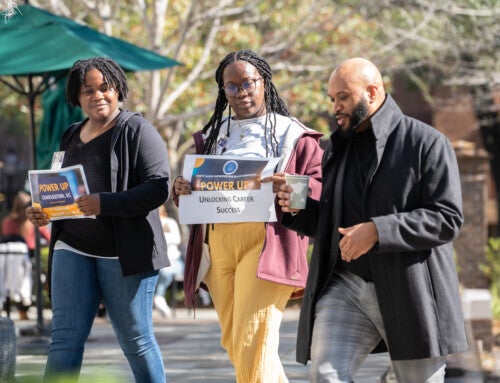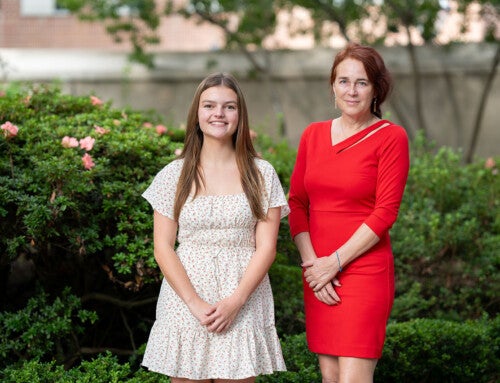Center For Undergraduate Research from College of Charleston Foundation on Vimeo.
You hear it time and time again from students at the College of Charleston: “At a bigger college, you’d probably need to be pursuing your master’s or doctorate to do the same kind of research we’re doing.”
The graduate-level type of research and creative inquiry opportunities for undergrads at CofC are world-class and are a big attraction to prospective students. And it happens across all disciplines.
“When prospective students come to campus, we can often convince them to come here instead of large research institutions because students can start research as early as their freshman year, an opportunity they may not get at a research-focused university,” says Elizabeth Meyer-Bernstein, interim dean of the Honors College.
However, the current model – which doesn’t include a full-time director or staff dedicated to expanding undergraduate research opportunities and awareness – isn’t sustainable or expandable.
“Currently, there is enough capacity to serve as a source of project support and nothing more,” says Meyer-Bernstein. “We could increase the number of projects funded by just throwing some more dollars into the mix, but that would not enhance our institution in the way in which the creation of a center could.”
Enter the Center for Undergraduate Research and Creative Inquiry, which will promote an innovative approach to multidisciplinary and interdisciplinary undergraduate research through a research hub at the College. It’s one of the nine philanthropic endeavors the College is prioritizing as part of the Drive for the 250th in honor of the 250th anniversary of its founding.
Imagine a dedicated space where students can go to specifically learn about student-faculty collaboration happening on campus. Right now, many students aren’t sure how to get involved with research unless they hear of opportunities directly from professors. This limits access to undergraduate research for many students on campus. Similarly, faculty are often looking for students, and this would be a place where they could identify and recruit students to work with them on projects.
“Nationally, an increased emphasis has been placed on undergraduate research and departments have incorporated it as a core component of their curriculum,” says Charlie Calvert, an associate professor in the School of the Arts who also also serves as the director of the Office of Undergraduate Research and Creative Activities. “Students engaged in experiential learning find enhancement and reinforcement of what they are seeing in classes; and it makes them more marketable for employers or graduate programs. This holds true for students in all disciplines. Having a center would amplify our efforts to bring high-impact experiential learning opportunities to all students on campus, giving them the best possible path to success.”
It also dovetails perfectly with the College’s new strategic plan. With the overriding goal to make CofC into a national university, the plan will guide the College over the next ten years. Improving the student experience and their chances for success is a core component, and one of the keys to that is research opportunities. The Center for Undergraduate Research and Creative Inquiry (CURCI) is critical in that regard.
“Fortunately, we already have a strong foundation of success to build upon,” notes Meyer-Bernstein. “Now is the time to capitalize on our success and launch a sustainable model on our campus.”
The goal of the drive is to raise $2.8 million to fund the center. Undergraduate research is a canonical example of experiential learning and is one of the standards of excellence used to measure nationally pre-eminent colleges. The current research model at CofC, however, is not adequately resourced to provide enough students with funded opportunities or give them the support needed to leverage their experience to gain entrance to the job market or graduate school.
“Investing in a center akin to what we have for study abroad and the Career Center will help to distinguish ourselves from some of our other competitors, and increase the success of our students, the quality of our institution and, consequently, the value of a CofC degree,” says Meyer-Bernstein.
It will also help with admissions.
“Institutions have recognized that well-conceived and managed undergraduate research programs not only serve our current students, but can also be an excellent tool for the recruitment of new students,” adds Meyer-Bernstein. “Showcasing faculty-student research is quickly becoming a primary public relations strategy that increases the visibility of academic programs and encourages students to get involved early on.”

Student Felise Horne explores painting techniques for her research project, Pixels to Pigment: Translating Traditional Scenic Art in the Digital Age.
Another important element to note is that these experiences are particularly impactful for students from underserved populations, so expanding research opportunities and resources will support an increase in campus diversity – another huge component of the strategic plan.
“We need to increase accessibility to excellence,” says Meyer-Bernstein. “Providing resources and opportunities for students that are typically under-represented in research is one way to do this and will be a main focus of CURCI.”
The CURCI would also foster collaboration between college and community partners to create a robust culture of sustainable undergraduate research that expands beyond disciplinary and campus boundaries. The creation of the center will be instrumental for CofC to achieve national recognition for the institution’s ability to develop students into “workforce ready” graduates through faculty mentored research.
“By creating the infrastructure to support the expansion of innovative undergraduate research including a full-time director, support staff and physical space with modern data tools, we can increase the opportunities for a more diverse group of students and provide much needed resources for faculty and student development,” says Meyer-Bernstein. “Many colleges and universities have these centers and it is necessary we institutionalize a sustainable model as a way to compete with our peers, and to offer our students the best possible educational experience.”
For the past 250 years, CofC students have generated new knowledge through collaborations with faculty, propelling them into the best graduate schools and jobs while leaving behind novel insights and discoveries that are part of the College’s fabric.
Says Meyer-Bernstein: “As we think about the next 250 years, we need to claim undergraduate research as part of our history, celebrate it, solidly ground it in our mission and embrace it as part of our identity for future students.”
Featured image: Brooke Van Horn, associate professor of chemistry, works with a student on research. (Photo by Heather Moran)





